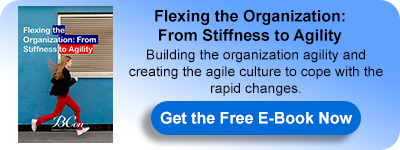An Agile Prepared Culture
The DNA of an Agile Organization1
Organizations have the problem of keeping up with quick adjustments in the marketplace brought on by the digital revolution in a constantly changing world. Traditional organizational structures and management approaches fail to modify their processes and outputs quickly, whereas agile businesses thrive in a changing environment.
Hence, with the increasing importance of agility and the concept becoming essential for today's business world, we have gathered some main characteristics and traits that distinguish agile organizations.
1. A Common Vision for the Entire Company
Agile organizations have a shared value to align as an organization while rethinking whom they serve and how they deliver value. They are client-centric and strive to address a wide range of needs throughout the customer life cycle. They're also dedicated to creating value with and for diverse stakeholders (for example, employees, investors, partners, and communities).
2. Customer-Centricity
Rather than focusing on improving operational processes to boost profit margins, agile businesses concentrate on knowing their customers' demands and developing personalized solutions. Making a profit is vital to agile businesses, and it is achieved by providing value to customers.
3. A Collection of Empowered Teams
While agile businesses have a typical top-down hierarchical structure, the rest of the organization is essentially a system of independent networked teams working toward a common goal.
4. Open Communication
It is easier for teams and individuals to receive the information they need to make smart decisions when communicating clearly and openly. It also enables them to do a great deal more quickly than they could in a system that imposes a communication structure defined by comprehensive policies and protocols for every contingency.
5. Learning and Decision-Making Processes are Quick
Agile businesses have short learning, product development, and decision cycles to respond quickly to an uncertain and ever-changing environment. This enables them to make small, focused changes over time that provide value incrementally.
6. Seamless Technology Integration
Agile firms try to truly incorporate new technology into their operational processes rather than just digitizing current activities. Further collaboration, communication, and project management technologies, for example, can save a lot of time while simultaneously introducing a new way of working together and managing projects.
An Agile Prepared Culture 2
Many companies begin their agile pilots in small groups. At the very least, they will be able to develop adaptive leadership skills there. However, to successfully spread agility throughout a company, senior executives must embrace its principles and be willing to dramatically improve their capabilities.
Leadership Commitment: As with any organizational transformation, leaders' commitment must be evident for people to have faith in their support.
Create Value, Growth, and Opportunity: The agile leader translates, aligns, communicates, and infuses their vision and what they anticipate the company to be into the organization's culture, strategy, and decision-making clearly and coherently, resulting in value growth and opportunity.
Genuine Leadership: Leaders need to model an organization's principles and 'instill trust.' People require trust to experiment, innovate, test, and learn without fear.
Design an Agile Culture: People's mindsets and communications—what they think, say, and do—make up the culture. Throughout the company, clearly define, coordinate, and reinforce essential vocabulary and behaviors.
Encouragement and Focus on Experimentation and Constant Feedback: Scheduled feedback loops are helpful, but business thrives when a company's culture fosters ongoing input. Everyone works together to strengthen client relationships and learn from them.
Create an Agile Strategy: An agile strategy necessitates leadership to create, align, and implement a collaborative, transparent, incremental, and experimental framework that is focused on customer needs. Change leadership, change management, and transition planning are essential tactics for an agile firm.
Collaboration Between Teams, Functions, and Specialties is Essential: Agile working relies heavily on collaboration. It's the process of connecting the dots across an organization to provide cohesive and integrated outputs.
Senior leaders must learn new mindsets and capabilities to transform themselves, their teams, and the business to construct and lead an agile organization. It's the responsibility of executives to plan, implement, execute, monitor, mitigate, and control agile organizations. Organizations with a shared purpose are better positioned to maintain a competitive advantage in the global corporate environment of the twenty-first century. They will have improved employee and stakeholder satisfaction and increased profitability and market brand equity.
1Accessed 20 Apr 2022, https://www.betterteam.com/what-is-an-agile-organization
Gallup, 28 Jun 2021, Marco Nink and Jennifer Robison, 10 Traits of Highly Agile Companies, Accessed 15 Apr 2022, https://www.gallup.com/workplace/351530/traits-highly-agile-companies.aspx
Mckinsey, 22 Jan 2018, Wouter Aghina, Karin Ahlback, Aaron De Smet, Gerald Lackey, Michael Lurie, Monica Murarka, and Christopher Handscomb, The five trademarks of agile organizations, Accessed 15 Apr 2022, https://www.mckinsey.com/business-functions/people-and-organizational-performance/our-insights/the-five-trademarks-of-agile-organizations
2LinkedIn, 17 Jan 2019, Pam Ashby, How Leaders Create an Agile Culture, Accessed 20 Apr 2022, https://www.linkedin.com/pulse/how-leaders-create-agile-culture-pam-ashby/
Mckinsey, 1 Oct 2018, De Smet, Michael Lurie, and Andrew St. George, Leading agile transformation: The new capabilities leaders need to build 21st-century organizations, Accessed 20 Apr 2022, https://www.mckinsey.com/business-functions/people-and-organizational-performance/our-insights/leading-agile-transformation-the-new-capabilities-leaders-need-to-build-21st-century-organizations
Forbes, 13 Feb 2020, Lori Harris, Agile Organizations: Seven Steps For Excellence, Accessed 20 Apr 2022, https://www.forbes.com/sites/forbescoachescouncil/2020/02/13/agile-organizations-seven-steps-for-excellence/?sh=5d88d12710a6
For more about this topic, download our latest book " Flexing the Organization: From Stiffness to Agility " for FREE:
